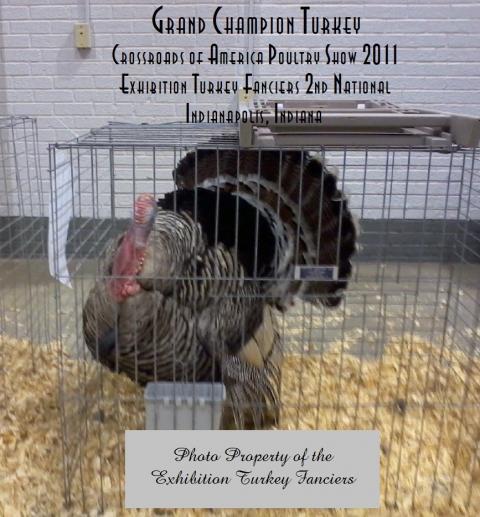One of our ETF Canadian members has requested the US Ambassador to Canada get involved. Not sure what that will do. We know the Governor's office is already talking to the Wyoming breeder. Maybe getting the Canadian government involved would help. At some point the USDA will have to respond.
My concern is if we allow one Game & Fish to make a regulation against livestock, they will all jump on board and start regulating us. We all recall the Muscovy duck fiasco.
Our ETF member has granted me permission to repost her letter to the US Ambassador on BYC:
Ambassador David Jacobson,
United States Ambassador to Canada,
The Embassy of the United States of America,
490 Sussex Drive,
Ottawa, Ontario
Dear Ambassador Jacobson,
It has been brought to my attention that it is considered illegal to either own or import into the State of Wyoming Narragansett turkeys. Apparently, the Wyoming Game and Fish Department classify this Heritage breed of turkey as a wild turkey, not a domestic one. By doing so, this takes away the management of the Narragansett turkey from the United States Department of Agriculture under which management of domestic breeds of turkeys currently falls and is accepted as such in all other States of the Union.
To better understand what is at issue here, please allow me to present the following information:
The history of the Narragansett turkey goes back to the 1600's when domestic black turkeys were brought to the American colonies by European settlers. Through years and years of successive selective breeding programs, originally crossing these black European turkeys with North American wild turkeys, the Narragansett was developed. It was the foundation breed of the New England turkey industry and soon became valued throughout North America and even back in Europe. The Narragansett, as a unique breed of turkey, was recognized by the American Poultry Association in 1874 as one of the original turkey breeds and it is the oldest turkey breed to be developed on the North American continent.
For the Wyoming Game and Fish Department, to rewrite history as they see fit, shows not only their disrespect for the proud history of this American bird, which by the way, one of your Founding Fathers, Benjamin Franklin, proposed as your National Bird in place of the Bald Eagle, but it also shows a scientific ignorance which one would not expect from a State Game and Fish department.
The Exhibition Turkey Fanciers, an international organization of which I am a member, have received a letter from the Wyoming Game and Fish Department that categorically states that Narragansett turkeys are not morphologically or behaviorally different from wild turkeys and is thus their basis for their erroneous policy (a photo of said letter is attached). In reality, it is a scientifically stated fact that the Narragansett turkey is phenotypically, genotypically and behaviorally different from any wild turkey breed. The Genotype of the Narragansett turkey is sex-linked (b+b+ngng for toms and b+b+ng- for hens). Phenotypically, the Narragansett differs from North American wild varieties in that its beak is horn colored, its head is red to bluish white and its beard is black. The shanks and feet are salmon colored (additional photos and information can be found at:
http://www.porterturkeys.com/narragansett.htm ). Furthermore, the Narragansett has been used in the development of other turkey types and is closely linked to the commercial broad breasted breeds so important to today's industry.
In conclusion, Mr. Ambassador, I would like to quote from a letter Dr. Tom Famula, a highly respected Geneticist at the University of California, Davis, sent to a fellow member of the Exhibition Turkey Fanciers:
"... As the instructor for Animal Science I for over 20 years, it would be a grave mistake on my part to not include Narragansett as a domesticated animal. Taken right from our class website, and from papers by Professor Price, the definition of a domesticated animal is:
A Domestic Animal is one that is bred in captivity for purposes of economic profit to a human community that maintains mastery over breeding, territory and food supply.
If these birds do not qualify under that definition, then what does? Though the exact date of domestication may be uncertain, it is easy to classify these noble, American birds as anything but wild. In fact, Google eBooks has been kind enough to provide an on-line copy of the American Standard of Perfection from 1905. And right on pages 254 and 255 there is the description of the Narragansett. As you well know, non-domesticated birds are not in that book; the book is for poultry and poultry only (remembering that poultry are domesticated birds).
Just having to write this note, brief as it may be, has me question why would anyone think otherwise. Though the Narragansett does not have the distinguished reputation of the Bronze when it comes to Thanksgiving imagery, the Narragansett remains anything but just another bird. If only we had a pilgrim to chat with..."
Mr. Ambassador, it is my sincere hope that you will convey through the appropriate diplomatic channels to both the Government of the State of Wyoming and the United States Department of Agriculture the need to clarify, once and for all, the classification of the Narragansett turkey and under which jurisdiction management thereof falls. Small family farmers are currently caught in the confusion caused by this Wyoming Game and Fish policy and, what is most important to myself as a Canadian Citizen and a member of the international group, Rare Heritage Turkeys - a discussion group on raising, preserving, and breeding Rare and/or Heritage Breeds of turkeys - is that this policy, if kept as is, would be detrimental to the saving of one of America's oldest breeds of poultry, a breed currently listed as "Threatened" by the American Livestock Breeds Conservancy. (
http://www.albc-usa.org/cpl/wtchlist.html#turkeys)
Mr. Ambassador, I wish you and yours an early "Happy (American) Thanksgiving".
Sincerely,
Cameron McNamee
Deux-Montagnes, QC.
J7R 4C9
(email removed by Jim)











